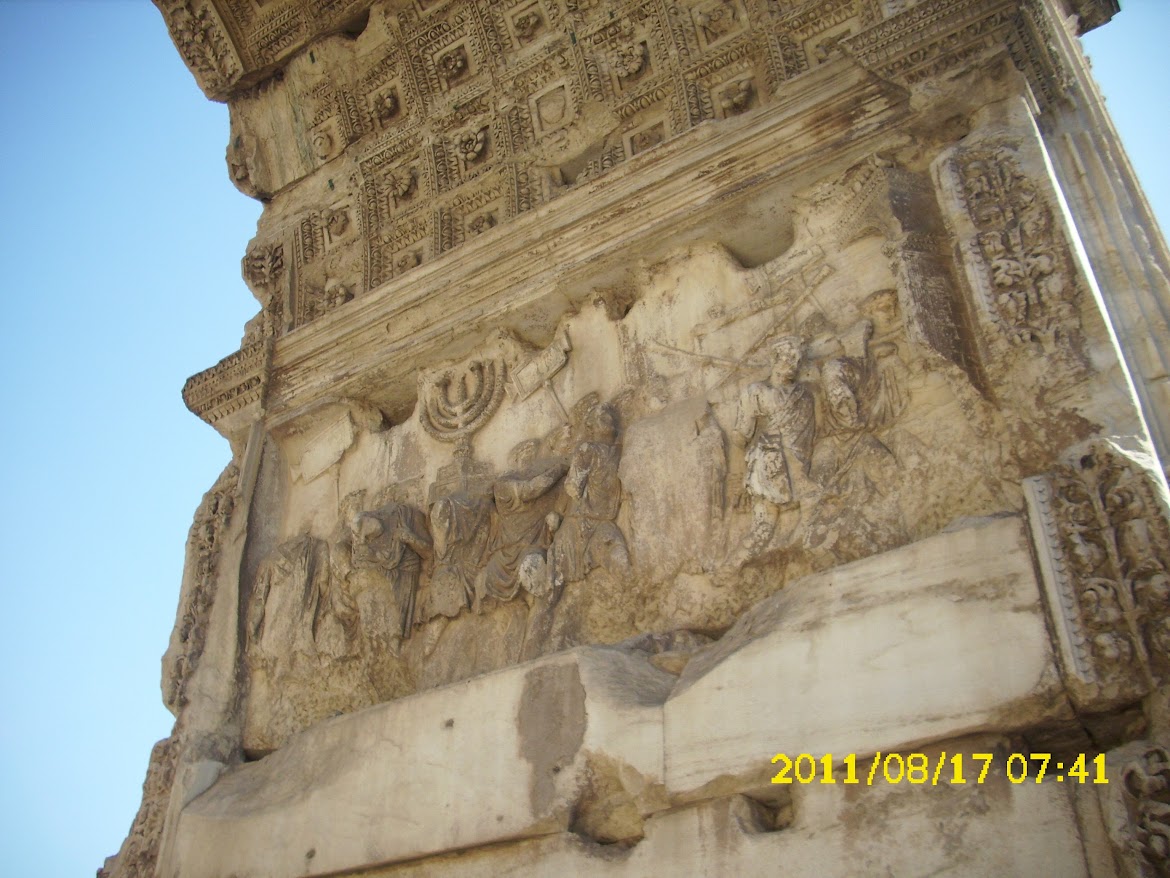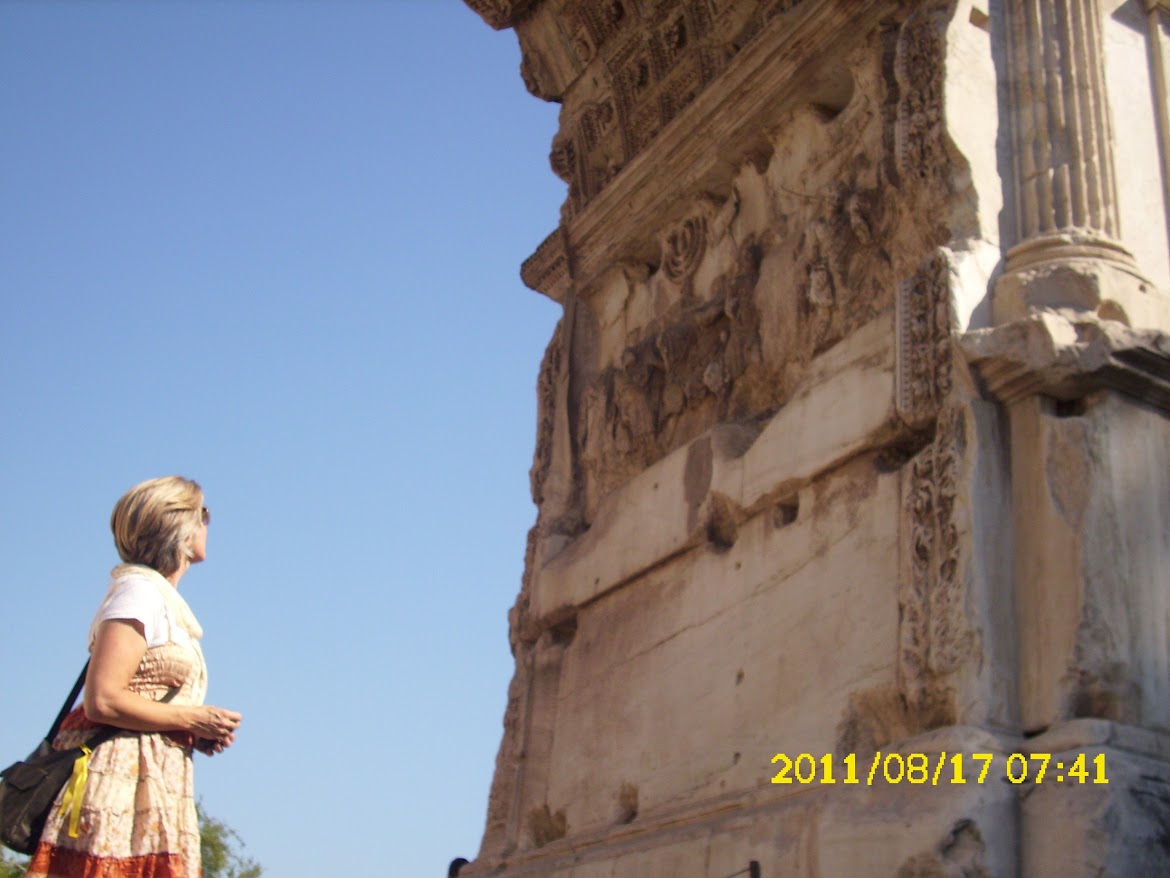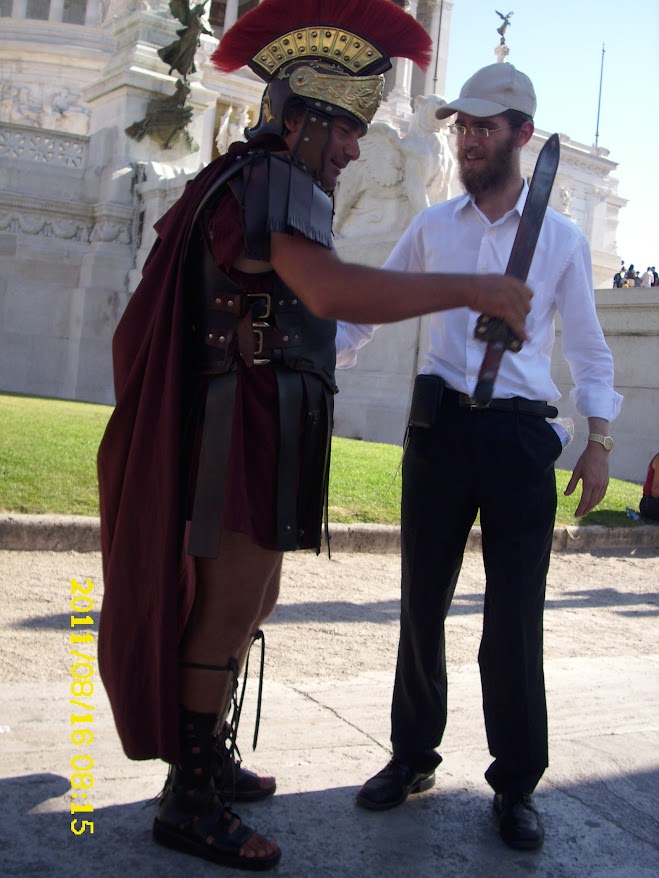המנורה: קדושה ויופי בפרשה “בהעלותך”
| Summer 2011. We are on a short family trip in Italy. There’s beautiful scenery. Landscapes. Museums. And it is impossible not to stop by the famous menorah carving in the Roman Forum in the old city of Rome. On top of Titus’ triumphal arch, the menorah appears as a symbol of the fall of the Jewish people at the hands of the Romans. Not far from there, a “Roman soldier” dressed in all his glory walks around, looking for tourists to take pictures with. A Jewish guy in black slacks, a white shirt, tzitzit and kippa approaches him and they shake hands. Thus 2000 years later, they stand opposite each other: one, representing a piece of history that is no more, and the other, representing an entire world, a living, vibrant, existing miracle. | קיץ 2011. אנחנו בטיול משפחתי קצר באיטליה. נופים. מראות. מוזיאונים. ואי אפשר בלי לעצור ליד תבליט המנורה המפורסם בפורום רומאנום בעיר העתיקה ברומא. על גבי שער הניצחון של טיטוס מופיעה המנורה כסמל לנפילת העם היהודי בידי הרומאים. לא רחוק משם, מסתובב “חייל רומאי” מחופש במלוא תפארתו, מחפש תיירים להצטלם איתם. בחור יהודי במכנסיים שחורים, חולצה לבנה, ציציות וכיפה ניגש אליו והם לוחצים ידיים. כך 2000 שנה אחרי, הם עומדים זה מול זה: אחד, כמייצג פיסת הסטוריה שאיננה עוד, ואחד, כמייצג עולם שלם, נס מהלך, חי וקיים. |
| Did the Romans coincidentally choose to commemorate their victory with a menora? Simply because “that’s the way it was”? This is how this week’s Torah portion, Be’ha’alotcha, begins: Hashem spoke to Moses, saying: Speak to Aaron and say to him, “When you mount the lamps, let the seven lamps give light at the front of the lampstand.” Aaron did so; he mounted the lamps at the front of the lampstand, as H’ had commanded Moses.— Now this is how the lampstand was made: it was hammered work of gold, hammered from base to petal. According to the pattern that H’ had shown Moses, so was the lampstand made (Numbers 8:1-4). | האם במקרה בחרו הרומאים להנציח את נצחונם במנורה? פשוט כי “ככה זה היה”? כך מתחילה פרשת השבוע, פרשת “בהעלותך”: וַיְדַבֵּ֥ר ה’ אֶל־מֹשֶׁ֥ה לֵּאמֹֽר׃ דַּבֵּר֙ אֶֽל־אַהֲרֹ֔ן וְאָמַרְתָּ֖ אֵלָ֑יו בְּהַעֲלֹֽתְךָ֙ אֶת־הַנֵּרֹ֔ת אֶל־מוּל֙ פְּנֵ֣י הַמְּנוֹרָ֔ה יָאִ֖ירוּ שִׁבְעַ֥ת הַנֵּרֽוֹת׃ וַיַּ֤עַשׂ כֵּן֙ אַהֲרֹ֔ן אֶל־מוּל֙ פְּנֵ֣י הַמְּנוֹרָ֔ה הֶעֱלָ֖ה נֵרֹתֶ֑יהָ כַּֽאֲשֶׁ֛ר צִוָּ֥ה ה’ אֶת־מֹשֶֽׁה׃ וְזֶ֨ה מַעֲשֵׂ֤ה הַמְּנֹרָה֙ מִקְשָׁ֣ה זָהָ֔ב עַד־יְרֵכָ֥הּ עַד־פִּרְחָ֖הּ מִקְשָׁ֣ה הִ֑וא כַּמַּרְאֶ֗ה אֲשֶׁ֨ר הֶרְאָ֤ה ה’ אֶת־מֹשֶׁ֔ה כֵּ֥ן עָשָׂ֖ה אֶת־הַמְּנֹרָֽה (במדבר ח:א-ד). |
| Rashi, based on Midrash Tanhuma, writes that the story of the menorah is near the story of the princes’ gifts from last week because … when Aharon saw the dedication of the princes, he was sad that he was not with them at the dedication, not him nor his tribe. The Holy One said to him, your life (language of swearing), your share is greater than theirs, for you light and fix the candles. It is understandable that Aaron was sad for not participating in the dedication of the tabernacle, but how is the lighting of the candles supposed to console him for that? | רש”י בהתבסס על מדרש תנחומא כותב שענין המנורה נסמך לפרשת הנשיאים בפרשת השבוע הקודמת, כי … כְּשָׁרָאָה אַהֲרֹן חֲנֻכַּת הַנְּשִׂיאִים חָלְשָׁה אָז דַּעְתּוֹ, שֶׁלֹּא הָיָה עִמָּהֶם בַּחֲנֻכָּה לֹא הוּא וְלֹא שִׁבְטוֹ, אָמַר לוֹ הַקָּבָּ”ה חַיֶּיךָ שֶׁלְּךָ גְדוֹלָה מִשֶּׁלָּהֶם, שֶׁאַתָּה מַדְלִיק וּמֵטִיב אֶת הַנֵּרוֹת. אפשר להבין שאהרון הצטער על שלא השתתף בחנוכת המשכן, אבל איך אמורה הדלקת הנרות לנחם אותו על כך? |
| According to our tradition, what was special about the candles was the miracle of the western candle that was not extinguished all day. The sages said of it that it is “a testimony to everyone that the Schina, the Divine Spirit, dwells within Israel”. That is, the menorah is not an item that is needed in the tabernacle for the purpose of offering sacrifices or storing and carrying the Tablets in the Ark of the Covenant. Compared with other items that were necessary, the function of the menorah is solely to publish the name of Gd in the whole world. It can be explained that it was also given to the Levites, who have no estate in the Land of Israel and their role is spiritual, therefore they are most suitable for this role. Therefore, it is no wonder that the Romans took the menorah and “showed off” its capture, as if in this act, they would take our light for themselves, and not so. | לפי המסורת שלנו, מה שהיה מיוחד בנרות הוא הנס בנר המערבי שלא היה כבה כל היום כולו. חז”ל אמרו עליו שהוא “עדות לכל באי עולם שהשכינה שורה בישראל”. כלומר, המנורה איננה פריט שצריך במשכן לצורך הקרבת הקורבנות או לצורך אחסון ונשיאת לוחות הברית, כמו ארון הברית. לעומת שאר החפצים שהיתה בהם נחיצות, מעשה המנורה הוא אך ורק כדי לפרסם את שם ה’ בעולם כולו. אפשר להסביר שלכן הוא גם ניתן לבני לוי, שאין להם נחלה בארץ ישראל וכל תפקידם הוא רוחני, ולכן הם מתאימים יותר לתפקיד זה. לכן גם לא פלא שהרומאים לקחו את המנורה ו”השוויצו” בכך, כאילו שבמעשה זה, יקחו אליהם את האור שלנו, ולא כן. |
| The menorah is built so that it is – beautiful, in its buttons, cups and flowers. Is it needed for the objects in the Tabernacle and later Temple to be “beautiful”? Isn’t it enough that they are “useful”, and what does beauty matter?? We find that the sages have a complex attitude towards beauty. | המנורה בנויה כך שהיא תהיה – יפה, בכפתוריה, גביעיה ופרחיה. האם צריך שהחפצים במשכן ובמקדש יהיו “יפים”? האם לא מספיק שיהיו “שימושיים”, ומה זה משנה היופי?? אנחנו מוצאים אצל חז”ל יחס מורכב ליופי. |
| Sometimes beauty is a good thing and sometimes not. Rabbi Yehoshua is described as an ugly man, and he explains this with a parable that, like good wine is kept in simple earthen vessels and not in “beautiful” gold and silver vessels, so is the wisdom of the Torah (Ta’anit 7:1). But about Rabbi Yochanan, the leader of the Land of Israel sages and the editor of the Jerusalem Talmud, it is said that he was extraordinarily beautiful, ‘and whoever wants to see (and understand) his beauty, should bring a new silver cup from the silversmith’s shop, when the silver is the whitest, and fill it with red pomegranate seeds, and put a wreath of red roses on the cup, and place it between the sun and shade. The same radiance that this image has, it is roughly like the beauty of Rabbi Yochanan‘ (translated from Aramaic with the help of Sefria, Baba Metzi’a 84:a). | לפעמים היופי הוא דבר טוב ולפעמים – לא. רבי יהושע מתואר כאדם מכוער, ומסביר זאת במשל, שכמו שיין טוב, מוחזק בכלי חרס פשוטים ולא בכלי זהב וכסף “יפים”, כך גם חוכמת התורה (תענית ז:א). אבל על רבי יוחנן, ראש חכמי ארץ ישראל ועורך התלמוד הירושלמי, מסופר שהיה יפה בצורה יוצאת דופן, ‘ומי שרוצה לראות (ולהבין) את יופיו, צריך להביא כוס כסף חדשה מבית הצורף, כשהכסף לבן ביותר, וימלא אותה גרעיני רימון אדום, וישים זר ורדים אדומים על פי הכוס, ויעמיד אותה בין החמה לצל. אותו הזוהר שיש לדימוי זה, הוא בערך כמו יופיו של רבי יוחנן’ (מתורגם מארמית בעזרת ספריא, בבא מציא פד:א). |
| The Maharsha explains that Rabbi Yohanan was the remnant of the glory of Jerusalem during the 2nd Temple period. At that time, there was a unity between holiness and beauty, and Rabbi Yohanan retained something of that in him, which also explains the great mourning over his death and the loss of his beauty. | המהרש”א מסביר שרבי יוחנן היה שארית התפארת של ירושלים בתקופת בית שני. בתקופה ההיא היתה אחדות בין הקודש והיופי, וברבי יוחנן נשאר בו משהו מכך, מה שגם מסביר את האבל הגדול על מותו ואובדן יופיו. |
| When we were exiled from our Land, the Shechinah was exiled too, and beauty became belonging to the nations of the world. For decades and hundreds of years, Jews have been portrayed in many caricatures as ugly, deformed and terrifying. But in the last decades with the return of the people of Israel to their Land, their place and who they are, holiness and beauty in our lives become more and more synchronized. | כשגלינו מארצנו, השכינה גלתה והיופי נהיה שייך לאומות העולם. במשך עשרות ומאות שנים היהודים צוירו בקריקטורות רבות כמכוערים, מעוותים ומבהילים במראם. אך בעשורים האחרונים עם חזרת עם ישראל לאדמתו, למקומו ולמי שהוא, הקודש והיופי בחיינו נהיים יותר ויותר מסוכרנים. |
| The Land is becoming more and more beautiful, we have Israeli beauty queens, Israeli actors and actresses are famous all over the world, and the painful and perhaps the strongest place to see the beauty of the people of Israel is, unfortunately, in the faces of the fallen. Every time a picture of someone who has fallen is published, it’s hard to believe that such beauty exists among us, and when you read about their lives, it’s even more clear how holiness and beauty are synchronized more than ever. | הארץ נהיית יפה יותר ויותר, יש לנו מלכות יופי ישראליות, שחקנים ושחקניות ישראלים מתפרסמים בכל העולם, והמקום הכואב ואולי החזק ביותר לראות את היופי של עם ישראל הוא, לצערנו, בפני הנופלים. בכל פעם שמתפרסמת תמונה של מישהו שנפל, קשה להאמין שיופי כזה מסתובב בינינו, וכשקוראים על חייהם, ברור עוד יותר כמה הקודש והיופי מסוכרנים יותר מאי פעם. |
| We are blessed to live in such a time, and may we continue to see the combination of beauty and holiness in life. | אשרינו שזכינו לחיות בזמן כזה, והלוואי שנמשיך ונזכה לראות את שילוב היופי והקודש בין החיים. |
שבת שלום – SHABBAT SHALOM




